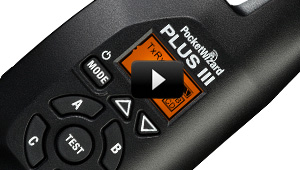 Today, Pocket Wizard rolled out the newest in their line of wireless flash triggering devices: the long-awaited update to the industry standard Pocket Wizard Plus II, the Pocket Wizard Plus III. We at Fstoppers have been playing with them for awhile, and we're here to give you all the details, including an exclusive video look at the new Pocket Wizard Plus III. [Pre Order The Pocket Wizard Plus III Here]
Today, Pocket Wizard rolled out the newest in their line of wireless flash triggering devices: the long-awaited update to the industry standard Pocket Wizard Plus II, the Pocket Wizard Plus III. We at Fstoppers have been playing with them for awhile, and we're here to give you all the details, including an exclusive video look at the new Pocket Wizard Plus III. [Pre Order The Pocket Wizard Plus III Here]
For years now, the Pocket Wizard Plus II has been the standard in wireless flash and camera triggers for professional photographers. One might ask why an upgrade is necessary, or why a new version is even needed. After all, they are reliable, consistent, readily-available and incredibly simple to use. Pocket Wizard knew they could take the best and make it better, and there's no question that these radio triggers are a huge improvement from the Plus IIs. A few of us here at Fstoppers.com were lucky enough to get our hands on a bunch of the new Pocket Wizards Plus III units, which are slated to be officially released in mid-March, and we put them through the test over the course of a handful of shoots. Our thoughts so far? They're absolutely awesome and totally worth upgrading! Check out our Pocket Wizard Review Video below to get all the details and see them in action:
Youtube Version:
Patrick Hall's Test Image

Thanks to Pratik Naik with Solstice Retouch for help with the composite.
Lee Morris's Test Image

Here's a rundown of the new features:
Modes
A variety of modes let you tailor the unit to the exact function you need.
TxRx: Transmits and receives. A standard transceiver mode, what you'll use most of the time when you are shooting with off-camera flash.
Tx ONLY: Disables all receiving functionality and allows you to use the Plus III only to transmit, best used when sharing the airspace with other photographers to prevent accidentally triggering the Plus III on your camera.
Rx ONLY: For use in an area where there are multiple photographers or flashes. This will prevent a remote Plus III from performing relay functions when mounted in the shoe of another camera or to prevent a Plus III from triggering other radios when the TEST button is pressed. For example, this would be the mode to use if the PWIII was triggering a remote camera.
LR (Long Range): Doubles (!) The maximum range of a radio in a given shooting environment. There may be a slight reduction in X-sync speed as a result.
RP (Repeater): Automatically re-transmits any triggers received on the selected channel. Can be used to dramatically extend working distance with flash or remote cameras when an additional Plus III is placed halfway between the camera or flash and the transmitting radio.
HSR (High-speed receive): Shortens the contact time of the flash/camera port, allowing for triggering of remote flashes at higher FPS. Up to 14.5, that is. Woah.
Other Features
A three-stage battery meter. This might be our favorite little upgrade - no more guessing at battery power.
The Antenna is contained entirely within the Plus III. No more broken antennas due to me tossing them in my bag at the end of a long day. In addition, the durability of the Plus III has also been changed for the better, at least it seems to me - they're a bit more solid-feeling and robust than the Plus IIs, and the buttons are made with heavy-duty rubber. They're built to last; make no mistake, your standard cheap trigger these are NOT.
A backlit LCD. This is going to be especially handy, as it seems half the time (at least) that I'm using flash, there is little-to-no ambient lighting.
Zones: Four assignable zones, each with it's own switch on the face of the unit. Think of sports shooters who have more than one set of lights in the rafters, or photographers using multiple remote cameras.
USB port for upgrading firmware and changing custom user settings (let me say that I've been a HUGE fan of this functionality on the Mini TT1 and Flex TT5s that I've been using). I also anticipate more functionality being added in the future, now that this is a standard feature.
PC Screw-Locking Cords now ship standard with the Pocket Wizard Plus III units. Fstoppers has been encouraging photographers to upgrade their loose and faulty PC Sync cords to the Nikon Screw-Lock PC cords for years (yes the work for Canon too). Now Pocket Wizard has included the upgraded PC sync cord with each unit along with a 1/8" to 1/4" adapter jack for your power packs taking the larger input connector. Nice touch Pocket Wizard!
Price
As anyone who has gone shopping for radio triggers knows, PocketWizard Plus IIs are usually one of the pricier options, despite their outstanding range and reliability. While you might expect the Plus III to cost more than the previous versions, as is the trend with nearly all photography-related items these days, they are actually priced lower than the Plus IIs, despite all of the improvements. The Plus III will be released with an MSRP of $139 in the US. That's right. Not only is it much better, it's much cheaper. This is going to be a HUGE game changer in the wireless trigger market.
Overall Review:

Our Thoughts
Mike Kelley: Despite suffering through recovery from a lower back surgery, I was eager to get out and put the new Plus IIIs through the ringer. From what I can tell, PocketWizard has hit an absolute home run with these. The first thing I noticed after unpacking them was how solid they felt: I've used a lot of triggers over the past few years and I can say that these are some tough little cookies. You'll never have to worry about them falling apart or malfunctioning on a shoot; I can't say the same for some of the cheaper triggers I've used.
I've been a long-time fan of the Flex TT5 and Mini TT1 triggers, and was looking forward to seeing how the Plus III would fit into my workflow. Integration was simple and seamless, and I didn't have any trouble getting everything working together perfectly. Since I do a lot of remote camera and flash triggering, the extended range mode and zone features are a welcome upgrade. In my testing, I didn't experience one misfire, granted I was shooting mostly indoors and at distances of at most 300 feet. Battery life also seems to be great so far. I'm also looking forward to see what PocketWizard does with the new USB and upgradeable software functionality in the future.
I've spent the better part of the week trying to think of ways to improve upon the Plus II and it seems that PocketWizard has covered all the bases. These are without question going to find themselves a permanent home in my gear bag, and I'm sure I'll enjoy getting acquainted with the new features I haven't used extensively yet.
Lee Morris: When I was told about these new units I was honestly worried. I've never been a big fan of the Multimax units because they were so overly complicated and I thought there was a chance that the Plus IIIs would wreck the simplicity of the Plus II units. Luckily I was very wrong. 99% of the time I am going to use these new units in the standard tranceiver mode and even still I think these things are worth the upgrade. The fact that these units are built better, HAVE A BATTERY INDICATOR! and have tons of extra features waiting to be used while at the same time being cheaper than the Plus II's makes this upgrade a no-brainer. I'm excited to change my fleet of 14 Pocket Wizards over to the new Plus IIIs.
Patrick Hall: It's pretty rare that I get really excited about a new piece of camera gear, but when the guys from PW called us to tell us what they had been working on, my ears perked up! Obviously the most exciting news is the new lower price. As said over and over again, the new battery indicator is my favorite new feature. I'm also really happy PW kept the standard AA battery instead of going with something less common or not rechargeable.
The new Group Mode feature is going to be so awesome for wedding photographers who often set up a few strobes on light stands so they can light their wedding receptions. The Pocket Wizard Plus III is going to change the way I shoot my own weddings for sure because I can now mix up my lighting schemes without having to run around adjusting lights and switching the individual remote channels. I'm also excited that Pocket Wizard has found a way to improve the overall radio transmission so that when you are shooting in the portrait orientation, the Pocket Wizards now fire much more reliably than they did in the past. Overall these units are well worth the upgrade and Pocket Wizard has brought us a nice unexpected gift for the new year.
Vimeo Version:




To learn more about the PocketWizard Plus III, head over to PocketWizard's Plus III mini-site, which contains every last (scintillating!) bit of information on these new units.







Is it possible that these are not compatible with Speedotron? When I tried to shoot with this last week, the PW were communicating with each other, but it seems that they did not with the Speedotron Power Pack 1205. Could you enlighten me?
Had the same problem and no idea why. This is frustrating.
I had the same problems with my old Balcar A 1200 and A2400 power packs. Check this: http://www.luminous-landscape.com/forum/index.php?topic=63928.0
Works absolutely perfect since I made it.
Best, Bernd
What is the maximum sync speed? Can you go above traditional 1/250 or 1/320??
I have a question, I just bought the Pocket Wizard Plus 3 and I attached it to my strobe and to my nikon d3100 and the wizard works great but when I take photos above a shutter speed of 200, black ( not quite black)starts to cover my image...and the higher the shutter speed the more black thats on the image...? I just dont know what to change or if its just the way my camera is reacting to the pocket wizards...has this happened to any of you?
*
Hey Guys,
Awesome work you are doing! Love your tutorials! I have 2 questions about thee babies.
1) To shoot the camera with these, you NEED a trigger release cable? The cables that come with the triggers won't do?
2) You mention above that in order to control the power of the flash guns with these triggers you need a Flex or mini, which would you suggest? And the sit on top of the camera under the PW trigger?
I normally use the Yongnuo which do allow you to control the power on both TTL and manual mode. But can't find it on these.